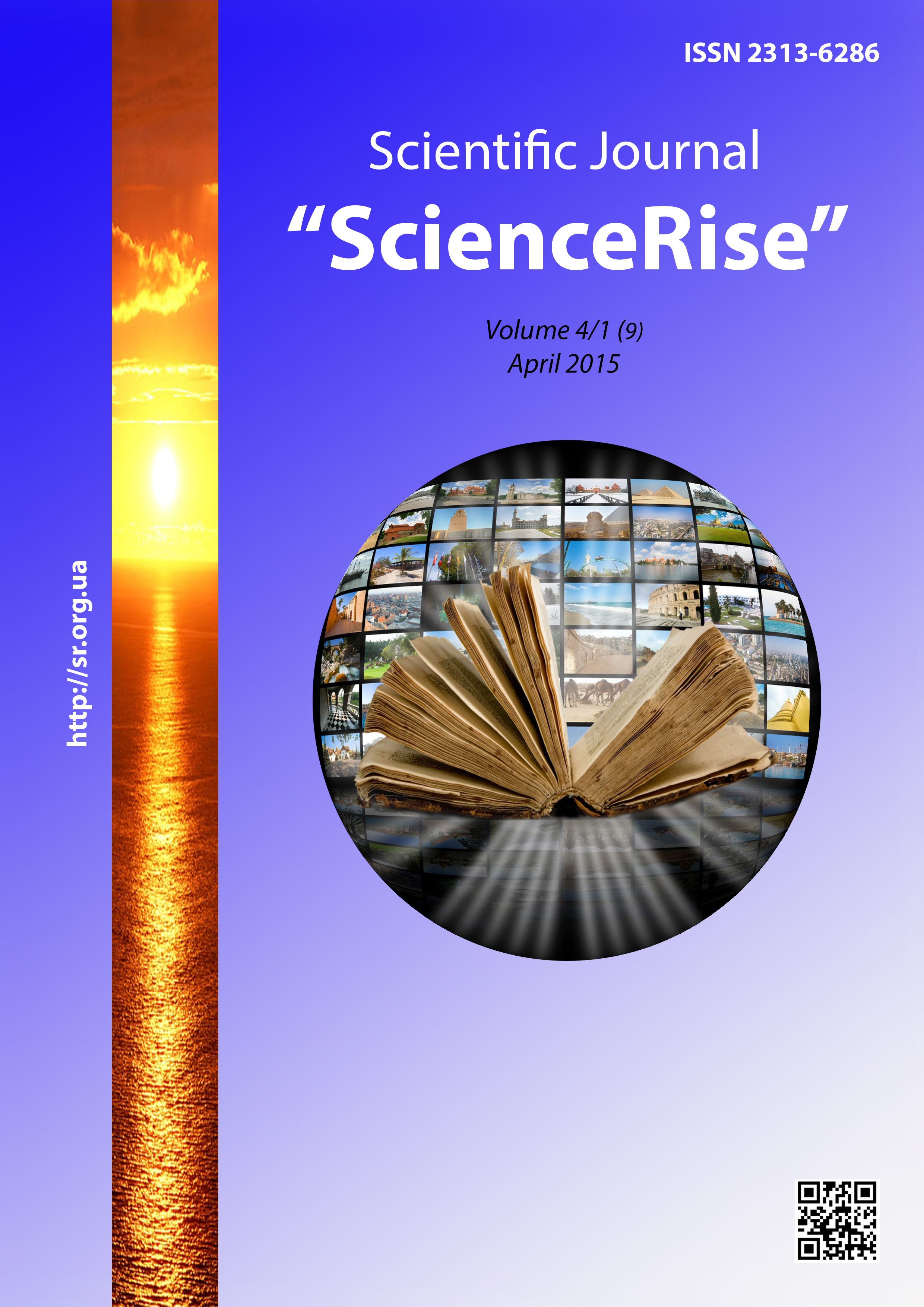Patterns of sand fractions influence on microalgae of the marine coast
DOI:
https://doi.org/10.15587/2313-8416.2015.41503Keywords:
phytopsammon, benthos, microalgae, abundance, sand grain compositionAbstract
To study effect of grain size on microalgae a new method is proposed: sand of different fractions is glued to the surface of microscope slides. Microalgae abundance was higher on fine sand grains (<0,25 mm). To forecast microalgae abundance the pattern is proposed depending on size of sand grains.
References
Rukhin, L. B. (1947). Granulometricheskiy metod izucheniya peskov. Lviv: Izd-vo Leningradskogo gosudarstvennogo un-ta, 213.
Jonge, V. N. (1985). The occurrence of Epipsammic diatom populations: a result of interaction between physical sorting of sediment and sertain properties of diatom species. Estuarine, coastal and shelf science, 21 (5), 607–622. doi: 10.1016/0272-7714(85)90061-7
Wotton, R. S. (2002). Water purification using sand. Hydrobiologia, 469, 193–201.
Saburova, M. A., Polikarpov, I. G., Burkovskiy, I. V. et al. (2001) Makromasshtabnoye raspredeleniye interstitsial'nogo mikrofitobentosa v estuarii reki Chernoy (Kandalakshskiy zaliv, Beloye more). Ekologiya morya, 58, 7–12.
Jewson, D. H., Lowry, S. F., Bowen, R. (2006). Co-existence of and survival of diatoms on sand grains. European Journal of Phycology, 41 (2), 131–146. doi: 10.1080/09670260600652903
Rybalkina, A. V., Kononenko, Ye. V.; Aniknev, V. V., Lukomskaya, K. A. (Eds.) (1977). Izucheniye mikroflory pochvy metodom obrastaniya stekol po N.G. Kholodnomu: rukovodstvo k prakticheskomu zanyatiyu po mikrobiologii. Moscow: Prosveshcheniye, 76–77.
Abakumova, V. A. (Ed.) (1983). Rukovodstvo po metodam gidrobiologicheskogo analiza poverkhnostnykh vod i donnykh otlozheniy. Lviv, Gidrometeoizdat, 240.
Hentschel, E. (1925). Die Untersuchungen von Strömen. Abderhalden: Hand. Deutsch. Biol. Arbeitsmeth, IX (2), 87–100.
Snigirova, A. A., Aleksandrov, B. G. (2014). Novyy podkhod v issledovanii mikrovodorosley peschanoy supralitorali. Al'gologiya, 24 (3), 435–439.
Arsan, O. M., Davidov, O. A., D'yachenko, T. M. et al.; Romanenka, V. D. (Ed.) (2006) Metodi gídroyekologíchniy doslídzhen' poverkhnevikh vod. NAN Ukraí̈ni, Ín-t gídrobíologii. Kiev: LOGOS, 408.
Round, F. E., Crawford, R. M., Mann, D. G. (1990). The Diatoms. Biology and morphology of the genera. Cambridge Univ. Press, 747.
Khaylov, K. M., Prazukin, A. V., Rabinovich, M. A. et al. (1994). Svyaz' biologicheskikh parametrov fitoobrastaniya s fizicheskimi parametrami eksperimental'nykh «rifovykh» konstruktsiy v yevtrofiruyemoy morskoy akvatorii Vodnyye resursy, 21 (2), 166–175.
Shimek, R. L. (2001). Sand Bed Secrets. The Common-Sense Way to Biological Filtration. Marc Weiss Companies, Inc. Ft. Lauderdale, Florida, 36.
Rieger, R. M., Ruppert, E. (1978). Resin embedments of quantitative meiofauna samples for ecological and structural studies – Description and application. Marine Biology, 46 (3), 223–235. doi: 10.1007/bf00390684
Snigireva, A. A., Aleksandrov, B. G. (2012). Vliyaniye granulometricheskogo sostava grunta na formirovaniye mikrofitobentosa Materialy tret'yey Mezhdunarodnoy nauchnoy konferentsii "Sovremennyye problemy gidrobiologii. Perspektivy. Puti i metody resheniy". Kherson, 121–124.
McLachlan, A., Brown, A. C. (2006). The Ecology of Sandy Shores, Elsevier Inc., 373.
Saburova, M. A., Polikarpov, I. G., Burkovskiy, I. V. et al. (2001). Makromasshtabnoye raspredeleniye interstitsial'nogo mikrofitobentosa v estuarii reki Chernoy (Kandalakshskiy zaliv, Beloye more), Ekologiya morya, 58, 7–12.
Snigirova, A. (2013). Benthic microalgae under the influence of beach nourishment in the Gulf of Odessa (the Black Sea). Botanica Lithuanica, 19 (2), 120–128. doi: 10.2478/botlit-2013-0015
Ravenel, W. S., Thistle D. (1981). The effect of sediment characteristics on the distribution of two subtidal harpacticoid copepod species. Journal of Experimental Marine Biology and Ecology, 50 (2-3), 287–301. doi: 10.1016/0022-0981(81)90055-1
Hennig, H. F.-K. O., Fricke, A. H., Greenwood, P. J. et al. (1982). Relationships between meiofaunal population densities and physico-chemical properties of unpolluted sandy beaches. Environmental Monitoring and Assessment, 1, 337–334. doi: 10.1007/bf00403834
Azovsky, A. I., Chertoprood, E. S., Saburova, M. A., Polikarpov, I. G. (2004). Spatio-temporal variability of micro- and meiobenthic communities in a White Sea intertidal sandflat. Estuarine, Coastal and Shelf Science, 60 (4), 663–671. doi: 10.1016/j.ecss.2004.03.005
Zaitsev, Yu. (2012). A key role of sandy beaches in the marine environment. J. Black Sea/Mediterranean Environment, 18 (2), 114–127.
Fenchel, T., Kofoed, L. H., Lappalainen, A. (1975) Particle size-selection of two deposit feeders: the amphipod Corophium volutator and the prosobranch Hydrobia ulnae. Marine Biology, 30 (2), 119–128. doi: 10.1007/bf00391586
Swedmark, B. (1964) The interstitial fauna of marine sand. Biological Reviews, 39 (1), 1–42. doi: 10.1111/j.1469-185x.1964.tb00948.x
Townsend, S. A., Gell, P. A. (2005). The role of substrate type on benthic diatom assemblages in the Daly and Roper Rivers of the Australian wet/dry tropics. Hydrobiologia, 548 (1), 101–115. doi: 10.1007/s10750-005-0828-7
Zaytsev, Yu. P. (2008). Soobshchestvo mikroorganizmov porovykh vod peschanykh plyazhey Chernogo morya. Fakty i gipotezy. Míkrobíologíya ta bíotekhnologíya, 2 (3), 8–20.
Aleksandrov, B. G. (2008). Gidrobiologicheskiye osnovy upravleniya sostoyaniyem pribrezhnykh ekosistem Chernogo morya. Kiyev: Naukova dumka, 344.
Downloads
Published
Issue
Section
License
Copyright (c) 2015 Anastasiya Snigirova, Borys Aleksandrov

This work is licensed under a Creative Commons Attribution 4.0 International License.
Our journal abides by the Creative Commons CC BY copyright rights and permissions for open access journals.
Authors, who are published in this journal, agree to the following conditions:
1. The authors reserve the right to authorship of the work and pass the first publication right of this work to the journal under the terms of a Creative Commons CC BY, which allows others to freely distribute the published research with the obligatory reference to the authors of the original work and the first publication of the work in this journal.
2. The authors have the right to conclude separate supplement agreements that relate to non-exclusive work distribution in the form in which it has been published by the journal (for example, to upload the work to the online storage of the journal or publish it as part of a monograph), provided that the reference to the first publication of the work in this journal is included.

